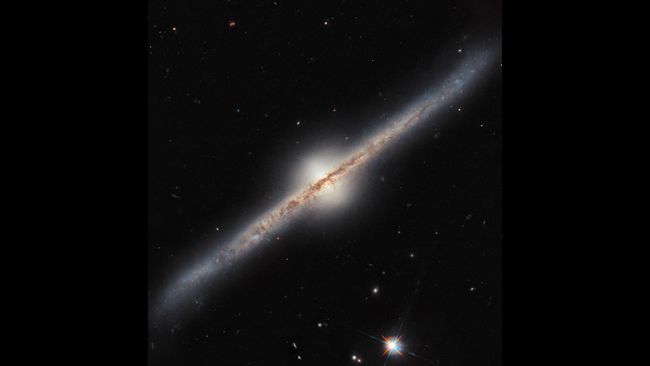Science
Related: About this forumSpace photo of the week: The tilted spiral galaxy that took Hubble 23 years to capture
By Jamie Carter published 4 hours ago
In this special Hubble image 23 years in the making, the sparkling spiral galaxy UGC 10043 reveals the secrets of its unusually big bulge.

A photo of a spiral galaxy
UGC 10043 is one of the few spiral galaxies we see edge-on. (Image credit: ESA/Hubble & NASA, R. Windhorst, W. Keel)
What it is: Spiral galaxy UGC 10043
Where it is: 150 million light-years away in the constellation Serpens
When it was shared: December 12, 2024
Why it's so special: This image of a spiral galaxy taken by the Hubble Space Telescope is a portrait more than two decades in the making.
Like most full-color images of space objects, it's a composite of images taken in different wavelengths of light. What sets this image apart, however, is that the data used to create it was collected during observation sessions in 2000 and 2023 — 23 years apart. That's one advantage of having a space telescope in orbit for so long: Hubble was launched from the space shuttle Discovery on April 24, 1990, and its long service has enabled it to capture a huge amount of data about every corner of the cosmos.
But besides the prolonged methods used to create it, it's also an unusual image on its face. Spiral galaxies — which account for about 60% of all galaxies in the universe, according to the European Space Agency — are, by chance, typically seen face-on when viewed from the solar system. That’s why spiral galaxies are typically associated with vivid spiral arms, which can only be seen from a face-on vantage. However, UGC 10043 is viewed edge-on, with its rings seemingly flattened into a line. This unique angle gives astronomers the chance to see how spiral galaxies are structured in 3D.
This image of UGC 10043 reveals obvious lanes of dust, which would likely look like spiral arms if the galaxy was seen face-on. Here, they appear to block the collective glow of the stars that make up the galaxy itself. They also contain dark clouds, which are star-forming regions.
At the center of the image is a bulge of light — the galaxy's bright core. All galaxies have one, but UGC 10043's is unusually large. Astronomers think it may be because UGC 10043 has collided with a dwarf galaxy nearby, leaving it with extra dust and gas that has fueled it to create new stars. A collision could also explain why the galaxy's disk is slightly warped, bending up at one end and down at the other.
More:
https://www.livescience.com/space/astronomy/space-photo-of-the-week-the-tilted-spiral-galaxy-that-took-hubble-23-years-to-capture
speak easy
(10,870 posts)Good jeans? sorry - I could not resist.